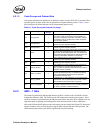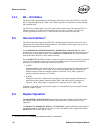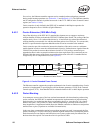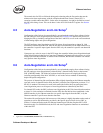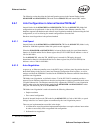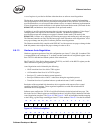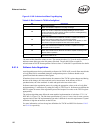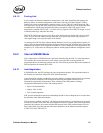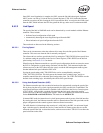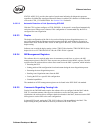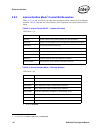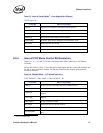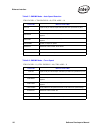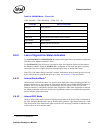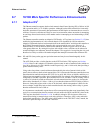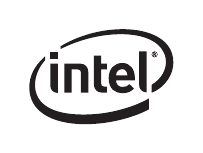
Software Developer’s Manual 163
Ethernet Interface
8.6.1.5 Forcing Link
In cases where the Ethernet controller is connected to a non-Auto-Negotiating link partner, the
hardware allows for manual configuration of the link via the Device Control register (CTRL).
Forcing link can be accomplished by software writing a 1b to CTRL.SLU which forces the TBI
PCS logic into a link up state if the LOS input is not asserted. Setting the SLU bit enables the MAC
to communicate with the internal SerDes and allows recognition of the LOS signal. If auto-
negotiation is enabled (TXCW.ANE = 1b) Set Link Up is ignored. The LINK UP# output, as well
as internal status logic, indicates link status.
The TXCW.ANE bit must be set to logic 0b to allow for forcing link. When link is forced via the
CTRL.SLU bit, the link cannot come up unless the LOS input is deasserted, implying there is a
valid signal being received by the optics or the SerDes.
An interrupt bit, RXCFG, flags software that the hardware is receiving configuration symbols (/C/
codes). Software should mask (enable) this interrupt when forcing link. When the link is forced, the
link partner can begin to Auto-Negotiate based due to a reset or enabling of Auto-Negotiation. The
reception of /C/ codes causes an interrupt to software and the proper hardware configuration can be
set.
8.6.2 Internal GMII/MII Mode
Link configuration in GMII/MII mode is generally determined by the PHY via Auto-Negotiation.
The software driver must intervene in cases where a successful link is not negotiated or a
programmer desires to manually configure the link. The following sections discuss the methods of
link configuration for internal PHY mode.
8.6.2.1 Auto-Negotiation
In GMII/MII mode, the PHY performs the Auto-Negotiation function. The operational details of
this function are described in the IEEE P802.3ab draft standard.
Auto-Negotiation provides a method for two link partners to exchange information in a systematic
manner in order to establish a link configuration providing the highest common level of
functionality supported by both partners. Once configured, the link partners exchange
configuration information to resolve link settings such as:
• Speed: 10/100/1000 Mb/s
• Duplex: Full- or Half-
• Flow Control Operation
PHY specific information required for establishing the link is also exchanged, but is not relevant to
the operation of the Ethernet controller.
If flow control is enabled in the MAC, the settings for the desired flow control behavior must also
be made by software in the PHY and Auto-Negotiation must be restarted. After Auto-Negotiation
completes, the software driver must read the MII registers in the PHY to determine the resolved
flow control behavior of the link and reflect these parameters in the Ethernet controller register
(CTRL.TFCE and CTRL.RFCE).



